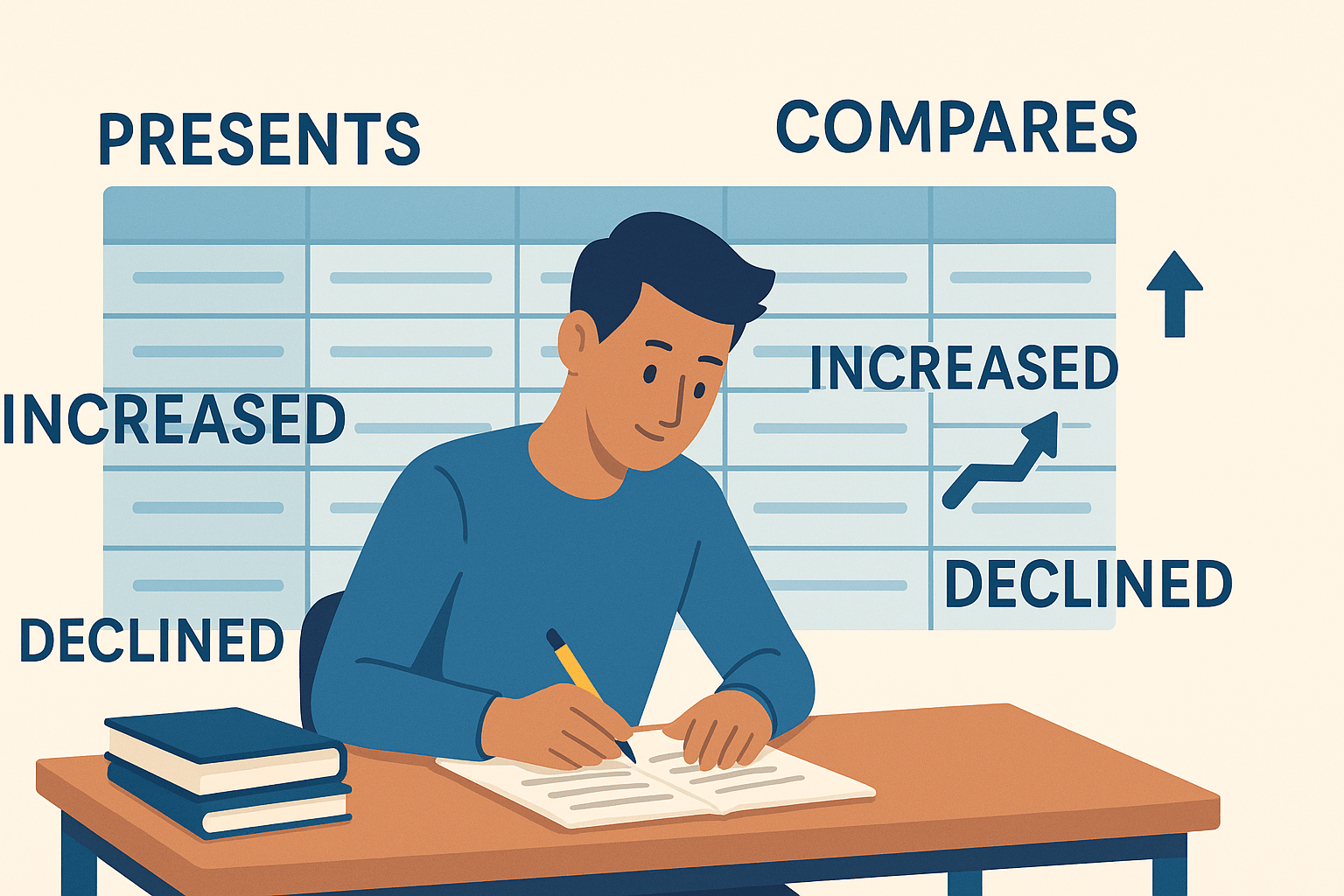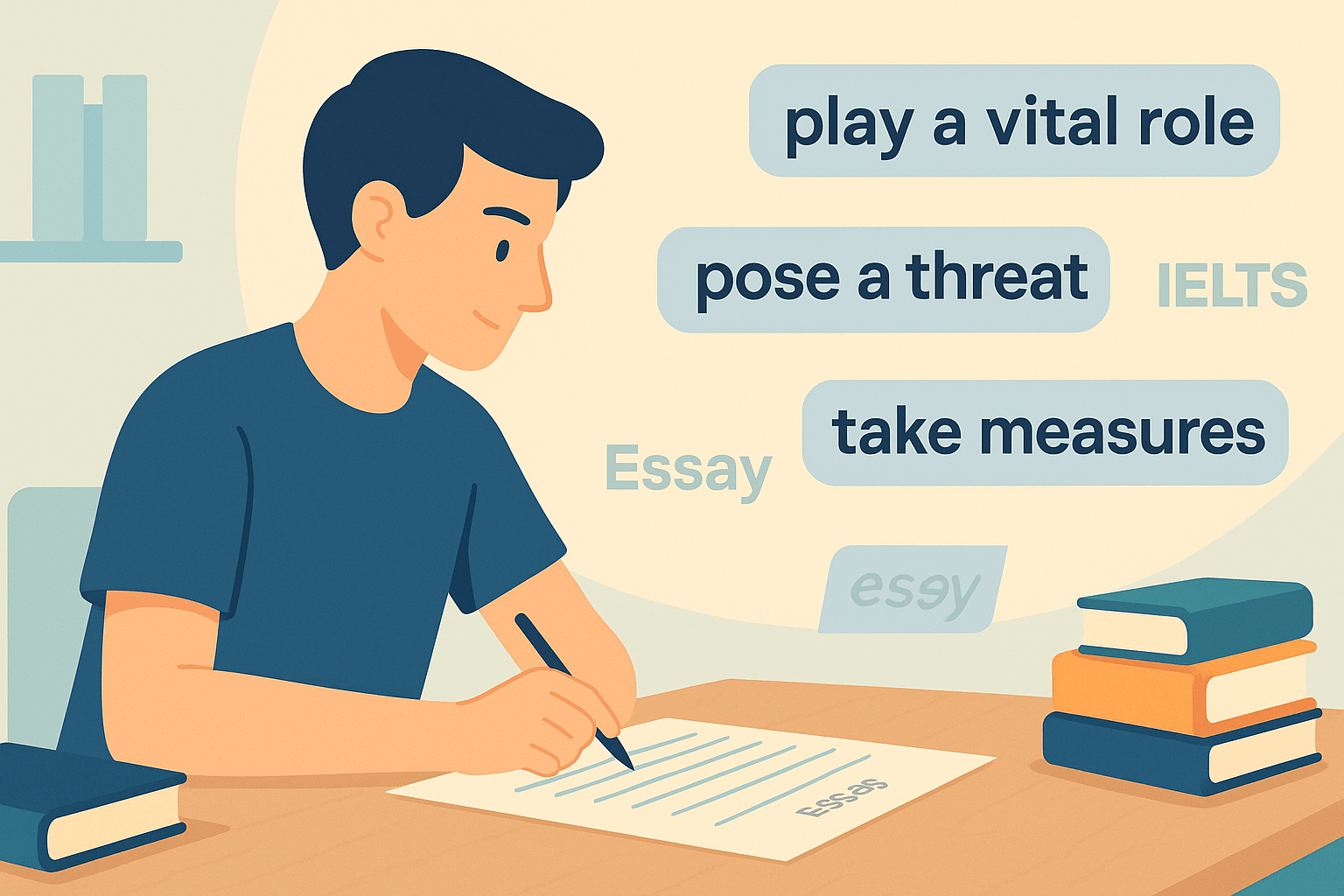- Why IELTS Table Vocabulary Matters
- Top IELTS Table Verbs (Beyond “Show” and “Give”)
- Describing Trends and Patterns
- Comparison and Contrast Vocabulary
- Adverbs and Degree Modifiers for Accuracy
- Academic Phrases to Sound Professional
- Sample IELTS Table Sentence Rewrites
- Frequently Asked Questions About IELTS Table Vocabulary
- Final Tips and Free Resource
IELTS Table vocabulary is the secret to transforming a confusing Writing Task 1 table into a clear, high-band essay.
I’ve taught countless students who freeze the moment they see a table full of rows, columns, and numbers. It can feel like a math test instead of English. But here’s what I always tell my students:
Once you understand how to describe tables clearly and have the right IELTS table vocabulary, your confidence skyrockets.
In this blog, I’ll teach you:
- ✅ The best verbs to describe tables (and avoid repeating “shows”)
- ✅ How to compare numbers and trends naturally
- ✅ Adverbs and modifiers to make your descriptions precise
- ✅ Academic phrases that impress the examiner without sounding forced
If you want to master all IELTS Writing Task 1 visuals, check out our IELTS Writing Task 1 Vocabulary: The Complete Guide to Graphs, Charts, and Diagrams — it’s the pillar guide that connects all chart types, including line graphs, bar charts, and pie charts.
Why IELTS Table Vocabulary Matters
In IELTS Writing Task 1, the examiner doesn’t just check what you write — they care how you write it.
If your essay is full of phrases like “the table shows” or “there is”, it will sound basic and repetitive. To achieve Band 7 or higher, your writing must:
- Use varied and precise vocabulary
- Maintain a formal, academic tone
- Summarize data clearly without describing every number
According to the official IELTS band descriptors, Lexical Resource is a key factor. That means your word choice directly impacts your score.
One of my students, Zara, once wrote “The table shows…” five times in her essay. After learning IELTS Table vocabulary like presents, depicts, and summarises, her writing instantly felt more academic and fluent — and her score jumped from Band 6 to 7.
Top IELTS Table Verbs (Beyond “Show” and “Give”)
Tables usually present information, but you need to vary your verbs to avoid repetition. Here are my go-to choices:
- Presents – “The table presents data on population growth in five cities.”
- Illustrates – “It illustrates the number of tourists visiting each country in 2022.”
- Displays – “The table displays employment rates by sector.”
- Depicts – “This table depicts electricity consumption over ten years.”
- Outlines – “It outlines the results of a customer satisfaction survey.”
- Summarises – “The table summarises income levels by education.”
Teacher Tip:
Use one verb in your introduction and switch to another later. This variety makes your writing feel fluent and polished.
Describing Trends and Patterns
Many IELTS tables show data over multiple years, meaning you’ll need to describe changes over time.
Useful Verbs for Change
- Increased / Rose – “The number of graduates increased steadily.”
- Decreased / Fell – “Tourism figures fell sharply after 2019.”
- Remained stable – “The figures remained stable throughout the decade.”
- Fluctuated – “Prices fluctuated during the five-year period.”
Nouns for Trends
- An upward trend / A gradual increase
- A sharp drop / A steady decline
- A noticeable fluctuation
Example:
“There was a sharp increase in online sales between 2018 and 2020.”
Pro Tip:
Don’t describe every number. Focus on main trends and key comparisons — that’s what earns you Band 7+.
Comparison and Contrast Vocabulary
Tables often require comparing rows and columns. Your score improves when you use formal comparison phrases instead of casual words like “a lot more.”
Useful Comparison Phrases
- Compared to – “Compared to 2015, the figures in 2020 were higher.”
- While / Whereas – “While the UK saw a steady rise, Spain experienced a decline.”
- In contrast – “In contrast, rural areas had much lower enrolment rates.”
- Slightly more / less than
- Nearly / almost double
- Twice as much as / half as much as
Example:
“Whereas 80% of men participated in sports, only 55% of women did.”
Teacher Tip:
Mix sentence starters (Compared to…) with inline connectors (while, whereas). This adds variety and cohesion to your essay.
Adverbs and Degree Modifiers for Accuracy
High-band essays show how much change occurs, not just that change happened.
Adverbs for Precision
- Slightly – “The figures rose slightly in 2018.”
- Moderately – “Spending increased moderately over the five-year period.”
- Significantly – “The unemployment rate dropped significantly.”
- Dramatically – “Sales rose dramatically after the new product launch.”
- Steadily – “The number of graduates increased steadily.”
Quantifiers for Proportions
- Just over / Just under – “Just over half of the students passed.”
- Approximately / Around / Roughly
- Nearly / Almost – “Nearly a third of participants were under 30.”
- Exactly / Precisely
Example:
“Just under 60% of people preferred public transport, while nearly 30% chose private cars.”
Academic Phrases to Sound Professional
Avoid casual words like a lot, went up, stayed the same. Use academic alternatives for a Band 7+ tone:
| Informal | Academic Alternative |
|---|---|
| A lot of | A significant number of / A large proportion of |
| Went up | Increased / Rose |
| Went down | Decreased / Declined |
| Stayed the same | Remained constant / Stabilised |
| More than half | The majority |
| Less than half | The minority / A small proportion |
Example Upgrade:
- ❌ “A lot of people used buses in 2020.”
- ✅ “A significant proportion of the population used buses in 2020.”
Sample IELTS Table Sentence Rewrites
See how small vocabulary upgrades make sentences exam-ready:
- Basic: “The table shows the number of people who visited museums in five countries.”
Improved: “The table presents data on museum visitors across five countries, with notable differences in attendance.” - Basic: “Spain had less visitors than Italy.”
Improved: “Spain received fewer visitors than Italy, with a noticeable gap of nearly 1.2 million.” - Basic: “More than half of the people liked watching TV.”
Improved: “A majority of respondents preferred watching television.”
Frequently Asked Questions About IELTS Table Vocabulary
Q1: What’s the best way to start a table description?
Paraphrase the title with a strong reporting verb:
“The table illustrates the number of households in three regions between 2010 and 2020.”
Q2: Do I have to describe every number?
No. Focus on:
- The highest and lowest values
- The overall trend
- Interesting comparisons
Q3: What tense should I use?
- Past tense for historical data
- Present tense for current data
- Future forms (will + verb) for predictions
Q4: How can I improve my IELTS table vocabulary quickly?
- Practice rewriting basic sentences with academic alternatives
- Create a vocabulary notebook
- Study real IELTS Task 1 samples on IDP IELTS and British Council
Final Tips and Free Resource
Mastering IELTS Table vocabulary will help you:
- ✅ Summarize data confidently
- ✅ Avoid repetitive language
- ✅ Sound academic and precise
Focus on:
- Key trends
- Major comparisons
- Accurate, formal vocabulary
Next Step: Strengthen your Task 1 skills with our IELTS Writing Task 1 Vocabulary: The Complete Guide, covering tables, charts, and diagrams.
With this vocabulary and practice, you’ll stop panicking and start writing like a Band 7+ candidate.






One Response